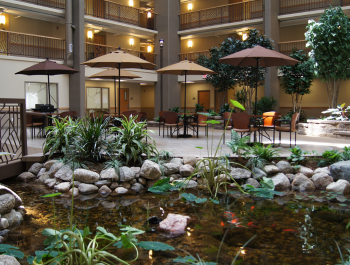Image

Rick Goodemann, CEO, Southwest Minnesota Housing Partnership
Challenge: Household hazards such as pests, mold, radon and lead erode residents’ quality of life, increase health risks and complicate housing affordability with high medical bills. Most of the oldest homes in the poorest condition are overwhelmingly occupied by residents with the least ability to address the problem.
Housing-based health hazards such as pests, mold and moisture, radon and lead erode residents’ quality of life, increase the likelihood of injury and illness and complicate housing affordability with excess medical expenses. In most communities, the oldest housing in the poorest condition is overwhelmingly occupied by households with the least ability to address the problem. These households may not have the knowledge, the physical ability or the financial resources to fix the problems or secure other housing.
Southwest Minnesota Housing Partnership (SWMHP), based in Slayton, MN, is a small nonprofit dedicated to creating thriving places to live, grow, and work through partnerships with communities. SWMHP provides community planning, real estate development, grant administration services and educational programs to communities in about thirty rural Minnesota counties.
Since 1992, our organization has inspected thousands of owner- and renter-occupied homes in Minnesota as part of housing rehabilitation programs. In Pipestone, Worthington, Mankato and other communities, low-income families with children, refugee and immigrant households, seniors and persons with disabilities had to choose between unaffordable housing and unhealthy housing. For families and communities to thrive, housing rehabilitation and design had to do more than meet minimum requirements.
We employ a health first approach in rehabilitation, new construction and community engagement programs, even when it isn’t the stated goal. In owner-occupied rehabilitation programs, which operate with a first-come first-served model, we met with public health nurses, community education providers and refugee programs to target resources to households with high risk of childhood lead poisoning, asthma and other health concerns.
Our health first response blossomed in 2004 with the rehabilitation of Viking Terrace Apartments, which had water damage, pests, ventilation issues and a disconnect from community. Through our involvement with Enterprise Green Communities, National Center for Healthy Housing, Blue Cross Blue Shield of Minnesota Foundation and the Center for Sustainable Building Research (University of Minnesota), Viking Terrace became a test case for green and healthy improvements in affordable housing.
We conducted meetings with residents and project partners to plan the redevelopment through a green and healthy lens and prioritize materials, design, and construction practices with likely health benefits. We focused on ventilation, pest management, moisture control, radon reduction and enhanced exterior space to encourage active recreation and community building. Two impact studies were conducted: the University of Minnesota measured water and energy conservation performance, and an NCHH study measured the health of residents compared to a pre-rehabilitation baseline. Researchers documented improvements in respiratory issues for children and adults and about one-third reported better overall health.
“Underhoused or unsheltered households have two to three times the healthcare costs of adequately housed households,” said Scott Johnson, executive director of Southwestern Mental Health Center. “We see health improvements for long-term homeless individuals who enter our supportive housing programs.”
 We improved four other properties, evaluating the lessons from previous projects to select high-impact investments for resident health. At Orness Plaza, a public housing building in Mankato in need of repair, we provided health-focused development services to another property owner. The renovation focused on ventilation, moisture and mold reduction, seamless integration of indoor/outdoor connections and onsite services. As part of the Green Rehabilitation of Elder Apartment Treatments Study, researchers documented that our rehabilitation choices resulted in improved mental and general physical health, prevented falls and reduced exposure to tobacco smoke. (Research partners included the National Center for Healthy Housing, Mankato EDA and the Center for Sustainable Building Research. The research project was funded by U.S. Department of Housing and Urban Development, Blue Cross Blue Shield Foundation of Minnesota and The McKnight Foundation.) The project also reduced management expenses through system upgrades and energy and water efficiency improvements.
We improved four other properties, evaluating the lessons from previous projects to select high-impact investments for resident health. At Orness Plaza, a public housing building in Mankato in need of repair, we provided health-focused development services to another property owner. The renovation focused on ventilation, moisture and mold reduction, seamless integration of indoor/outdoor connections and onsite services. As part of the Green Rehabilitation of Elder Apartment Treatments Study, researchers documented that our rehabilitation choices resulted in improved mental and general physical health, prevented falls and reduced exposure to tobacco smoke. (Research partners included the National Center for Healthy Housing, Mankato EDA and the Center for Sustainable Building Research. The research project was funded by U.S. Department of Housing and Urban Development, Blue Cross Blue Shield Foundation of Minnesota and The McKnight Foundation.) The project also reduced management expenses through system upgrades and energy and water efficiency improvements.Through our healthy housing initiatives, we’ve learned that:
- Owners, renters and property managers need to be engaged to take advantage of the health benefits of better buildings
- Establishing green and healthy property management standards in our more than 1,600 housing units empowers residents and encourages managers to suggest effective green and healthy cleaning products and support healthy resident behaviors regarding waste and recycling
- Our home maintenance courses, when paired with Adult Basic Education and English Language Learner courses, have been especially effective in targeting households most vulnerable to poor housing conditions
- Healthy housing assessments, which reach high-need households identified through school nurses, social workers and church leaders engage public health and housing inspectors to provide balanced perspective on physical condition of housing as well as behaviors that affect a family’s health
- Partnerships with local public health agencies and city housing inspectors generate interest from new funders, enabling us to better target housing rehabilitation funds and assessments with support from state, federal and private resources.

